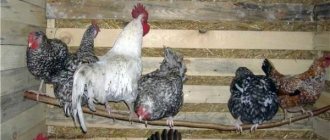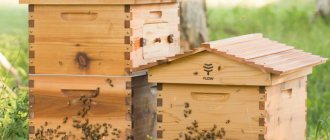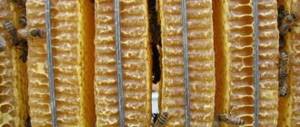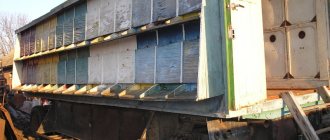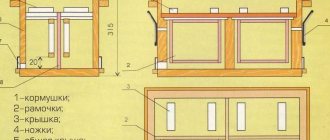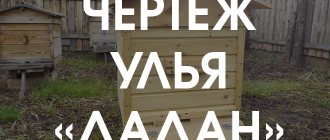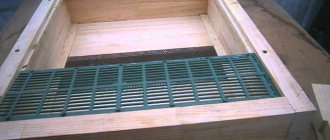Purpose and principle of operation
If you have only one hive, then you may well abandon the honey extractor. After all, then honey can be taken directly from the frames, breaking off the honeycombs.
But if you own a large number of bee colonies, then a honey extractor is simply necessary to pump out honey efficiently. From a design point of view, the equipment is a centrifuge consisting of a non-propeller (a stable tank that does not move during operation) and a rotating drum.
DIY honey extractor
On a note ! Inside this drum there is a certain number of cassettes, corresponding in size to the frames and rotating around their own axis. The honeycombs removed from the hive are mounted on cassettes. Then, when the latter rotate, honey flows out of the honeycombs and is drained into containers through a special hole.
The main advantage of using a honey extractor is that the integrity of the honeycombs is preserved, so they can be reused. If we consider store models, the most popular are Falco manual . The line of Italian honey extractors includes both two- and eight-frame designs. If the hives are non-standard, then it is better to make the equipment yourself.
Honey extractor from a plastic barrel
DIY cultivator
The cheapest option is to choose a plastic barrel as the base for the honey extractor. In addition, this design will be the simplest option and is suitable for beginner beekeepers.
Plastic has a number of advantages:
- not subject to rust;
- does not absorb odors;
- Easily cleared from honey.
In addition to the plastic barrel, you need to prepare: boards, metal rods, shelves and a rotation element.
You need to install a rotation element in the center of the barrel. A drill or bicycle pedal device is suitable for this. Thus, a manual honey extractor is assembled. You can use an element from an old electrical appliance. Shelves should be attached to it, acting as cassettes. You can use ready-made refrigerator shelves as shelves.
Honey extractor from a plastic barrel
As you pedal, the cassette begins to rotate. At this time, honey from the honeycomb will fall on the walls of the barrel and flow down. Boards and metal rods are needed to secure the tank itself.
Types of honey extractors
The type of design will depend on the technical specifications. Depending on how the cassettes are arranged, the devices are divided into two groups.
Radial
In them, the cassettes are located along the radial perimeter. Thanks to this design, the integrity of the honeycomb is preserved as much as possible, and a lot of honey can be pumped out in one go.
Chordial
Here the cassettes are located on the chords of the circle.
In this case, you can install no more than four cassettes. Typically, when using a chordial honey extractor, the risk of damage to honeycombs is higher. In turn, chordial devices can be divided into:
- negotiable _ They have hinges on the axes, on which the cassettes are then installed. Thanks to this, the drum can be rotated manually in one direction or the other;
- non- negotiable In this case, honey is pumped out from one side of the honeycomb, and then they are turned over and the other side is emptied;
- reversible . They work on the same principle as reverse ones, only the rotation is automatic, not manual.
Note ! When choosing a material for manufacturing, be sure to take into account its tendency to oxidize. The lower this indicator is, the longer the device will last and the better the quality of honey.
Chordial equipment
Experienced beekeepers should know that a chordial honey extractor can be converted into a radial one. Thanks to it, you can pump out about forty frames. However, it has disadvantages - it is not capable of pumping out rapeseed honey fully.
Steps for transforming the chordial device:
- to install the drum from the bottom, you need to weld rings made by yourself from eight millimeter wire;
- the ring is made from a profile or corner on top, and grooves are also introduced into which frames with honeycombs can be installed;
- Before using the device, it is important to wash all internal parts, paint them, and anoint them with beeswax.
The resulting equipment has many advantages, the main one of which is that during use, all honeycombs and frames remain intact and unharmed. The design includes a huge drum with a lever. The drum contains a metal sheet (perforated). This design prevents the penetration of foreign substances into the honey. The device also includes a convenient control unit and speed control.
High level of development of beekeeping in Ukraine
Types of designs depending on the drive
Another criterion that determines the type of design is the drive. Let's consider this classification of honey extractors.
Electrically driven
As you probably guessed from the name, these honey extractors operate from the mains. It is extremely difficult to make such a unit yourself, although with experience and skills it is quite possible to cope with this.
Electric honey extractor
The centrifuge in such designs rotates thanks to a battery or network (the first option is beneficial if pumping is carried out in the field). Electrically driven devices are suitable for large apiaries that produce tons of honey.
Expert opinion
Ponomarev Sergey Stepanovich
Beekeeper with 30 years of experience, Candidate of Technical Sciences
The main advantage is that the direction and speed of movement can be controlled. But there is also a minus - the devices are dependent on the energy source, and they are also quite difficult to maintain.
Without electric drive
Here the drum is rotated manually. The classic design of a honey extractor, so to speak. The advantages include relatively low cost, as well as the ability to operate in any conditions. Such designs differ from models with an electric drive in that they are independent of the power source. The disadvantages include the low pumping speed and difficulties in controlling the speed of movement, which can cause damage to the cells.
DIY drinking bowl for bees
To learn more
Bee hive made of polystyrene foam
To learn more
DIY Kandy for bees
To learn more
DIY thermal chamber for bees
To learn more
Video - Several options for homemade honey extractors
Master Class. Six-frame honey extractor with automatic reversal of cassettes
Let's look at the manufacturing process of a honey extractor using the following design as an example. For the work, the author purchased a 20 mm metal strip, and also ordered bearing units from a turner. After that I got down to business. In the photos below you can see how everything happened and what happened in the end.
Initially, the barrel was supposed to be round, but, upon reflection, the author realized that the square one was in no way inferior to it (except for the protruding corners and dimensions).
A regular pipe was used for draining, the angle was 90 degrees. A nut welded on one side from a squeegee of the same diameter acted as a plug.
Note ! The walls and bottom of the structure are covered with galvanized steel. Additionally, the lower joints were treated with silicone-based sealant.
The revolving cassettes were made of galvanized mesh 1.1 cm and strip 2x0.4 cm. A mechanism was also installed for their (cassettes) synchronous reversal. In the future, it is recommended to install a spring block on each cassette so that after each stop of the equipment they return to the radial position. The cassettes are supported by ball bearings. In turn, the moving mechanism on which the cassettes are located also rests on the ball (in addition, there are bearing units at the bottom and top).
The electric drive is made using a 350-watt brushed motor (the author took it from an old washing machine). The connection is made through a car inverter (2000 watts and 220 volts). In addition, a 12-volt gasoline generator was additionally made for the honey extractor (a Ural saw was used) in case the intensity of pumping increased, and also to prevent the battery from being discharged before the pumping process was completed.
In the images you can see what the control unit looks like, as well as the electric drive for a homemade design.
And then you see the honey drain valve in operation. In addition, we showed a Chinese converter (12-220 volts). Its power is 2000 watts and is sold in stores for approximately 2400-2500 rubles.
Note ! Before starting work, we advise you to make a drawing and prepare a test layout (cardboard or paper). The easiest to manufacture is considered to be a honey extractor designed for three to four frames. As for the diameter of the drum, it will depend directly on the number and dimensions of the frames. Maximum diameter – 65 cm.
Making cassettes for honey extractor with your own hands
An important element of the honey extractor are the cassettes; they are used to hold the frames while the honey is being pumped out. To make cassettes, you need to purchase the following materials:
- Galvanized mesh with cells.
- Aluminum rivets and a key for them.
- To ensure side fastening from the side, special corners will be required.
- Bulgarian.
- Welding.
- Pliers, hammer.
Cassettes for honey extractor
For cassettes, it is best to use high-quality stainless steel; some beekeepers use wooden blocks, plywood, and ordinary iron.
The mesh is made from galvanization. For the cassette frame you will need metal rods; if you don’t have them, you can make them from wire. First carefully form the mesh, then secure it by welding.
Design features of the Japanese hive and technology for working with it
Please note that if you need to make cassettes for a large frame, they must be wide. To do this, you need to attach tin corners to the top and bottom of the cassettes, so they will become reliable and rigid. In the table you can see the parameters.
Table “Dimensions of cassettes for honey extractor”
| Options | Size |
| Length | 50 cm |
| Width | 30 cm |
| Height | No more than 6 cm |
| Weight | Up to 1 kg. |
The design may be different, but it is important that the cassettes can be inserted into the honey extractor without any problems, the honeycombs must fit tightly to the mesh; if this rule is not followed, deformation of the honeycombs may occur when pumping out honey.
To impregnate the inside of the cassettes, you will need to use a special drying oil; it must be resistant to moisture; the top is covered with wax or varnish. It is important to thoroughly polish the device, so it will be environmentally friendly and protected from rotting. It is imperative to pre-treat it, this way you can prevent the honey from affecting the material. It will be possible to use the device for a long time.
It is important to store honey extractor cassettes correctly
- Wash after use.
- Stored in a safe place, which should be dry and protected from moisture and sun.
- Use only for honey extractor.
To make cassettes correctly, you need to use special drawings. Below is a drawing that makes it possible to familiarize yourself with the sequence of rotations of the cassettes.
Drawing “Turns of cassettes”
Other options for creating a honey extractor
There are many design options. Let's look at a few more examples of what a homemade design can be.
Wooden
Let’s say right away that it is very important here what kind of wood will be used for the work. Wet, resinous wood is definitely not worth taking. What you need for work:
- planed boards 20 mm;
- aluminum plates 30x40x20 mm;
- wooden slats 10x40 mm;
- bars 26x26 and 30x50 mm.
Expert opinion
Smirnov Dmitry Filipovich
Experienced beekeeper who knows everything about honey and the life of bees
It is important to make the legs high enough to install a 10-liter bucket under the drain.
The boards are processed with a plane so that their thickness is no more than 20 mm. For the sidewalls, it is better to use one solid board, also pre-processed with a plane. All elements of the body must be sheathed with 20 mm boards, the width of which is 190 mm. The length of the boards should be longer than what is needed, since they should be sanded after fastening. It is also important to fasten the boards so that the grain runs crosswise.
The lower sections of elements A and B (see drawing) are sheathed with 10x40 mm slats. At the bottom of part B, a 20 mm hole is made for pumping out honey. Then a rubber seal is inserted into it, and a wooden plug of the appropriate size is selected.
Important ! To make the structure more stable, the legs are constructed from 30x50 mm bars. The height can be any. For greater stability, they can be fixed at a slight angle, and crossbars made of 50 mm wide bars can be installed between them.
Made of aluminum
An aluminum honey extractor is made in almost the same way as from a washing machine. You can use any suitable container for the drum - for example:
- barrel;
- pan, etc.
Even a plastic barrel can serve as a body. It is only important that the plastic is of sufficient quality. This honey extractor does not need a stand - it can be placed on the table, and a bucket for honey can be placed underneath.
